教程:使用CSS设置数据样式¶
本教程将展示如何使用CSS来设置层的样式,以及等效的SLD代码。
要使用本教程,您需要 CSS extension 以及 states 图层来自 default GeoServer configuration 。
为状态层创建样式¶
默认的SLD文件 states 层如下:
<?xml version="1.0" encoding="ISO-8859-1"?>
<StyledLayerDescriptor
version="1.0.0"
xmlns="http://www.opengis.net/sld"
xmlns:ogc="http://www.opengis.net/ogc"
xmlns:xlink="http://www.w3.org/1999/xlink"
xmlns:xsi="http://www.w3.org/2001/XMLSchema-instance"
xmlns:gml="http://www.opengis.net/gml"
xsi:schemaLocation="http://www.opengis.net/sld
http://schemas.opengis.net/sld/1.0.0/StyledLayerDescriptor.xsd
">
<NamedLayer>
<Name>USA states population</Name>
<UserStyle>
<Name>population</Name>
<Title>Population in the United States</Title>
<Abstract>A sample filter that filters the United States into three
categories of population, drawn in different colors</Abstract>
<FeatureTypeStyle>
<Rule>
<Title>< 2M</Title>
<ogc:Filter>
<ogc:PropertyIsLessThan>
<ogc:PropertyName>PERSONS</ogc:PropertyName>
<ogc:Literal>2000000</ogc:Literal>
</ogc:PropertyIsLessThan>
</ogc:Filter>
<PolygonSymbolizer>
<Fill>
<!-- CssParameters allowed are fill (the color) and fill-opacity -->
<CssParameter name="fill">#4DFF4D</CssParameter>
<CssParameter name="fill-opacity">0.7</CssParameter>
</Fill>
</PolygonSymbolizer>
</Rule>
<Rule>
<Title>2M - 4M</Title>
<ogc:Filter>
<ogc:PropertyIsBetween>
<ogc:PropertyName>PERSONS</ogc:PropertyName>
<ogc:LowerBoundary>
<ogc:Literal>2000000</ogc:Literal>
</ogc:LowerBoundary>
<ogc:UpperBoundary>
<ogc:Literal>4000000</ogc:Literal>
</ogc:UpperBoundary>
</ogc:PropertyIsBetween>
</ogc:Filter>
<PolygonSymbolizer>
<Fill>
<!-- CssParameters allowed are fill (the color) and fill-opacity -->
<CssParameter name="fill">#FF4D4D</CssParameter>
<CssParameter name="fill-opacity">0.7</CssParameter>
</Fill>
</PolygonSymbolizer>
</Rule>
<Rule>
<Title>> 4M</Title>
<!-- like a linesymbolizer but with a fill too -->
<ogc:Filter>
<ogc:PropertyIsGreaterThan>
<ogc:PropertyName>PERSONS</ogc:PropertyName>
<ogc:Literal>4000000</ogc:Literal>
</ogc:PropertyIsGreaterThan>
</ogc:Filter>
<PolygonSymbolizer>
<Fill>
<!-- CssParameters allowed are fill (the color) and fill-opacity -->
<CssParameter name="fill">#4D4DFF</CssParameter>
<CssParameter name="fill-opacity">0.7</CssParameter>
</Fill>
</PolygonSymbolizer>
</Rule>
<Rule>
<Title>Boundary</Title>
<LineSymbolizer>
<Stroke>
<CssParameter name="stroke-width">0.2</CssParameter>
</Stroke>
</LineSymbolizer>
<TextSymbolizer>
<Label>
<ogc:PropertyName>STATE_ABBR</ogc:PropertyName>
</Label>
<Font>
<CssParameter name="font-family">Times New Roman</CssParameter>
<CssParameter name="font-style">Normal</CssParameter>
<CssParameter name="font-size">14</CssParameter>
</Font>
<LabelPlacement>
<PointPlacement>
<AnchorPoint>
<AnchorPointX>0.5</AnchorPointX>
<AnchorPointY>0.5</AnchorPointY>
</AnchorPoint>
</PointPlacement>
</LabelPlacement>
</TextSymbolizer>
</Rule>
</FeatureTypeStyle>
</UserStyle>
</NamedLayer>
</StyledLayerDescriptor>
现在,让我们从一个完成相同任务的CSS文件开始。
首先,转到样式页并单击 Add a new style 链接以开始新样式。在“新样式”页面中,执行以下操作:
为新样式命名您喜欢的任何样式,例如
csstutorial选择
CSS作为格式在 Generate a default style 下拉选择
Polygon然后点击 Generate...
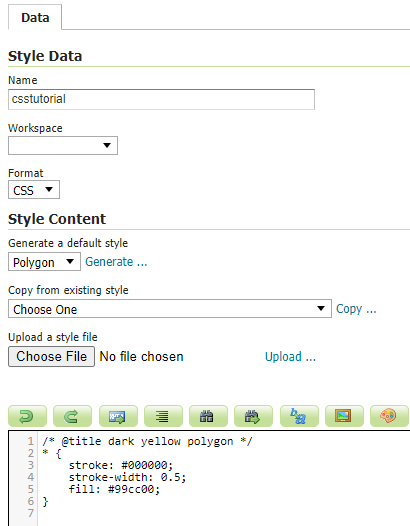
创建新的CSS样式¶
这将创建一个示例样式,其源与此样式类似(颜色可能不同)::
/* @title cyan polygon */
* {
stroke: #000000;
stroke-width: 0.5;
fill: #0099cc;
}
这演示了CSS样式的基本元素:
A 选择器 它标识要设置样式的数据的某些部分。这里,选择器是 * 指示所有数据都应使用样式属性。
属性 在花括号内 ({{}} )它指定了受影响的特性应该如何设置样式。属性由冒号分隔的名称/值对组成 (: )
我们还可以看到设计多边形样式的基础 (fill )及其大纲 (stroke )
在继续之前,让我们保存样式并使用状态层预览它:
单击“应用”保存层并启用样式预览
现在在“样式编辑器”页面,切换到“图层预览”选项卡,单击“图层预览”链接,然后在对话框中选择“状态”图层。
样式编辑器现在应该显示填充和删除的状态层。
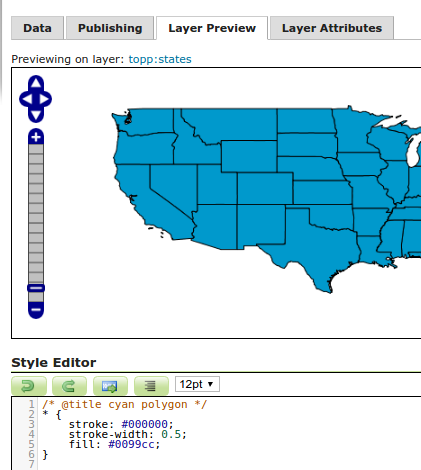
使用状态层预览CSS样式¶
让我们用这些基础知识开始翻译状态样式。SLD中的第一条规则适用于 PERSONS 字段小于200万::
<Rule>
<Title>< 2M</Title>
<ogc:Filter>
<ogc:PropertyIsLessThan>
<ogc:PropertyName>PERSONS</ogc:PropertyName>
<ogc:Literal>2000000</ogc:Literal>
</ogc:PropertyIsLessThan>
</ogc:Filter>
<PolygonSymbolizer>
<Fill>
<!-- CssParameters allowed are fill (the color) and fill-opacity -->
<CssParameter name="fill">#4DFF4D</CssParameter>
<CssParameter name="fill-opacity">0.7</CssParameter>
</Fill>
</PolygonSymbolizer>
</Rule>
使用A CQL -基于选择器,复制cssparameter的名称和值,我们得到:
[PERSONS < 2000000] {
fill: #4DFF4D;
fill-opacity: 0.7;
}
对于第二种样式,我们有 PropertyIsBetween 筛选器,它不直接转换为CSS::
<Rule>
<Title>2M - 4M</Title>
<ogc:Filter>
<ogc:PropertyIsBetween>
<ogc:PropertyName>PERSONS</ogc:PropertyName>
<ogc:LowerBoundary>
<ogc:Literal>2000000</ogc:Literal>
</ogc:LowerBoundary>
<ogc:UpperBoundary>
<ogc:Literal>4000000</ogc:Literal>
</ogc:UpperBoundary>
</ogc:PropertyIsBetween>
</ogc:Filter>
<PolygonSymbolizer>
<Fill>
<!-- CssParameters allowed are fill (the color) and fill-opacity -->
<CssParameter name="fill">#FF4D4D</CssParameter>
<CssParameter name="fill-opacity">0.7</CssParameter>
</Fill>
</PolygonSymbolizer>
</Rule>
然而, PropertyIsBetween 可以很容易地被两个比较选择器的组合替换。在CSS中,只需一个接一个地放置多个选择器,就可以对一个规则应用多个选择器。只有空格分隔的选择器必须全部满足才能应用样式。多个这样的组可以通过用逗号分隔来附加到一个规则 (, )。如果某个功能与某个规则的任何逗号分隔组匹配,则应用该样式。因此,第二条规则的CSS等价物是:
[PERSONS >= 2000000] [PERSONS < 4000000] {
fill: #FF4D4D;
fill-opacity: 0.7;
}
第三条规则的处理方式与第一条规则大致相同:
[PERSONS >= 4000000] {
fill: #4D4DFF;
fill-opacity: 0.7;
}
第四条也是最后一条规则有点不同。它将标签和大纲应用于所有状态:
<Rule>
<Title>Boundary</Title>
<LineSymbolizer>
<Stroke>
<CssParameter name="stroke-width">0.2</CssParameter>
</Stroke>
</LineSymbolizer>
<TextSymbolizer>
<Label>
<ogc:PropertyName>STATE_ABBR</ogc:PropertyName>
</Label>
<Font>
<CssParameter name="font-family">Times New Roman</CssParameter>
<CssParameter name="font-style">Normal</CssParameter>
<CssParameter name="font-size">14</CssParameter>
</Font>
<LabelPlacement>
<PointPlacement>
<AnchorPoint>
<AnchorPointX>0.5</AnchorPointX>
<AnchorPointY>0.5</AnchorPointY>
</AnchorPoint>
</PointPlacement>
</LabelPlacement>
</TextSymbolizer>
</Rule>
这引入了呈现提取值的思想 (STATE_ABBR )直接进入地图,不同于目前所有的规则。为此,可以使用括在方括号中的cql表达式 ([] )作为CSS属性的值。还需要将包含空白的值括起来,例如 Times New Roman ,单引号或双引号 (" , ' )。考虑到这些细节,让我们编写规则:
* {
stroke-width: 0.2;
label: [STATE_ABBR];
label-anchor: 0.5 0.5;
font-family: "Times New Roman";
font-fill: black;
font-style: normal;
font-size: 14;
}
把它们放在一起,你现在应该有一个如下的风格:
[PERSONS < 2000000] {
fill: #4DFF4D;
fill-opacity: 0.7;
}
[PERSONS >= 2000000] [PERSONS < 4000000] {
fill: #FF4D4D;
fill-opacity: 0.7;
}
[PERSONS >= 4000000] {
fill: #4D4DFF;
fill-opacity: 0.7;
}
* {
stroke-width: 0.2;
label: [STATE_ABBR];
label-anchor: 0.5 0.5;
font-family: "Times New Roman";
font-fill: black;
font-style: normal;
font-size: 14;
}
单击 Apply 用于保存更改的按钮。
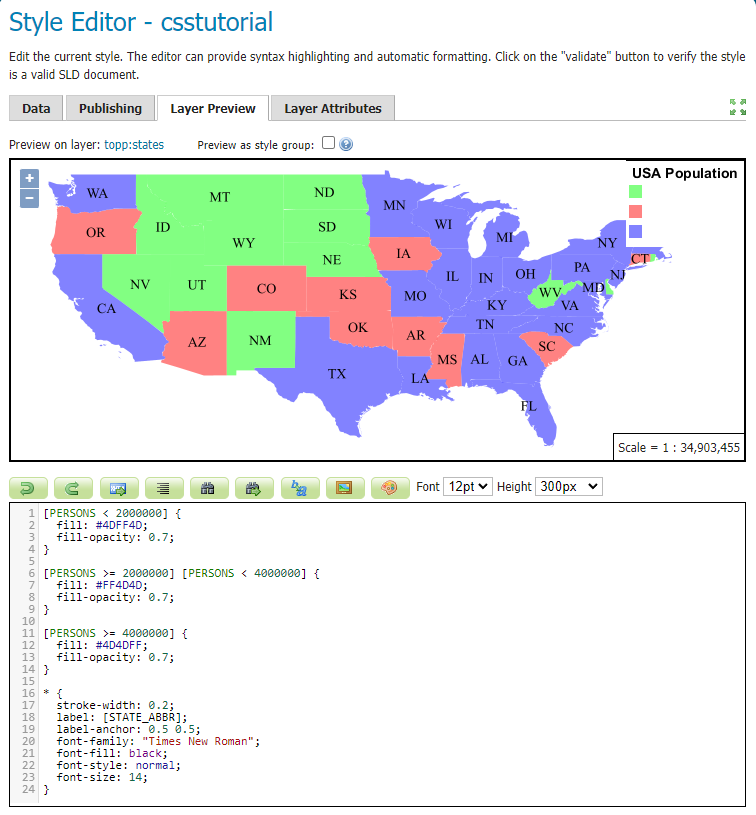
应用于 states 图层¶
你会看到边界不见了!在geoserver css模块中,每种符号都有一个“key”属性,用于控制是否应用它。如果没有这些“键”属性,则忽略从属属性。这些“键”属性是:
fill ,控制是否应用多边形填充。这指定了用于填充的颜色或图形。
划 ,控制是否应用线条和多边形轮廓笔划。这指定笔划的颜色(或图形填充)。
mark ,控制是否绘制点标记。这将标识要使用的已知标记或图像URL。
标签 ,它控制是否在地图上绘制标签。这标识用于标记地图的文本,通常作为CQL表达式。
halo-radius ,控制是否在标签周围绘制光环。这指定了这样的光晕应该有多大。
参见
这个 属性清单 有关其他属性的信息。
因为我们没有指定 stroke 颜色,不应用笔划。让我们添加它,替换最后一个规则,使其现在看起来像这样:
* {
stroke: black;
stroke-width: 0.2;
label: [STATE_ABBR];
label-anchor: 0.5 0.5;
font-family: "Times New Roman";
font-fill: black;
font-style: normal;
font-size: 14;
}
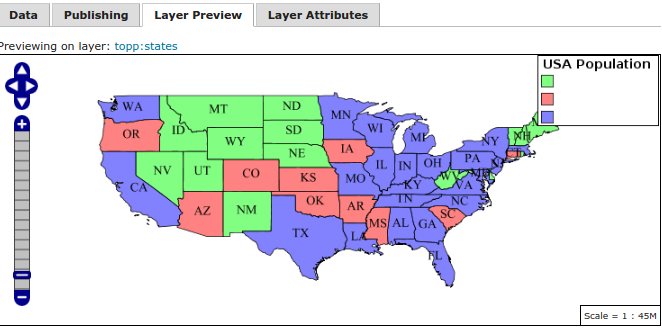
添加到样式的边框¶
改进风格¶
正在删除重复的属性¶
我们现在拥有的样式只有23行,比我们开始使用的103行XML有了很大的改进。但是,我们仍在重复 fill-opacity 属性无处不在。
我们可以把它移到 * 把它应用到任何地方。这是因为geoserver css模块模拟 级联 :虽然sld使用“painter's model”独立处理每个规则,但级联样式允许您提供常规样式属性,并仅覆盖特定功能的特定属性。
这使得样式只剩下21行:
[PERSONS < 2000000] {
fill: #4DFF4D;
}
[PERSONS > 2000000] [PERSONS < 4000000] {
fill: #FF4D4D;
}
[PERSONS > 4000000] {
fill: #4D4DFF;
}
* {
fill-opacity: 0.7;
stroke-width: 0.2;
label: [STATE_ABBR];
label-anchor: 0.5 0.5;
font-family: "Times New Roman";
font-fill: black;
font-style: normal;
font-size: 14;
}
比例相关样式¶
这种样式的标签很不错,但在较低的缩放级别,它们看起来有点拥挤。我们可以很容易地将标签移动到一个直到刻度分母低于2000000才会激活的规则。我们确实希望在所有缩放级别上保持笔划和填充不透明度,这样可以将它们与标签属性分开。
在主目录中保留以下属性 (* )规则::
* {
fill-opacity: 0.7;
stroke-width: 0.2;
}
删除其余所有内容,将其移动到新规则中:
[@sd < 20M] {
label: [STATE_ABBR];
label-anchor: 0.5 0.5;
font-family: "Times New Roman";
font-fill: black;
font-style: normal;
font-size: 14;
}
设置图例标题¶
到目前为止,我们还没有为任何样式规则设置标题。这不会在查看地图时造成任何问题,但GeoServer在自动生成图例图形时使用标题。如果没有标题,geoserver将返回名称,在css模块中,这些名称是根据每个规则的筛选器生成的。标题通常不是CSS的一部分,所以geoserver会在每个规则之前在特殊格式的注释中查找它们。我们可以添加这样的标题:
/* @title Population < 2M */
[PERSONS < 2000000] {
...
/* @title 2M < Population < 4M */
[PERSONS > 2000000] [PERSONS < 4000000] {
...
/* @title Population > 4M */
[PERSONS > 4000000] {
...
/* @title Boundaries */
* {
...
由于CSS转换为SLD的方式,每个SLD规则都是多个CSS规则的组合。这是通过将标题与单词“with”组合来处理的。如果规则省略了标题,那么它就不会包含在SLD输出中。
最后的CSS应该如下所示:
/* @title Population < 2M */
[PERSONS < 2000000] {
fill: #4DFF4D;
fill-opacity: 0.7;
}
/* @title 2M < Population < 4M */
[PERSONS >= 2000000] [PERSONS < 4000000] {
fill: #FF4D4D;
fill-opacity: 0.7;
}
/* @title Population > 4M */
[PERSONS >= 4000000] {
fill: #4D4DFF;
fill-opacity: 0.7;
}
/* @title Boundaries */
* {
stroke: black;
stroke-width: 0.2;
fill-opacity: 0.7;
}
[@sd < 20M] {
label: [STATE_ABBR];
label-anchor: 0.5 0.5;
font-family: "Times New Roman";
font-fill: black;
font-style: normal;
font-size: 14;
}
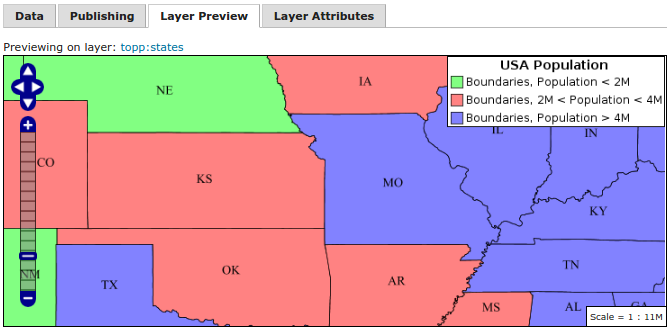
带有规则名称的最终样式¶
应用规则嵌套¶
作为最后的变体,可以通过利用规则嵌套使样式更紧凑:
* {
stroke: black;
stroke-width: 0.2;
fill-opacity: 0.7;
/* @title Population < 2M */
[PERSONS < 2000000] {
fill: #4DFF4D;
};
/* @title 2M < Population < 4M */
[PERSONS >= 2000000] [PERSONS < 4000000] {
fill: #FF4D4D;
};
/* @title Population > 4M */
[PERSONS >= 4000000] {
fill: #4D4DFF;
};
/* Labelling */
[@sd < 20M] {
label: [STATE_ABBR];
label-anchor: 0.5 0.5;
font-family: "Times New Roman";
font-fill: black;
font-style: normal;
font-size: 14;
}
}
CSS研讨会¶
有关更多详细信息,请访问下一节 CSS workshop .此研讨会过去用于课堂设置以教授CSS扩展,并已移植到用户文档中。